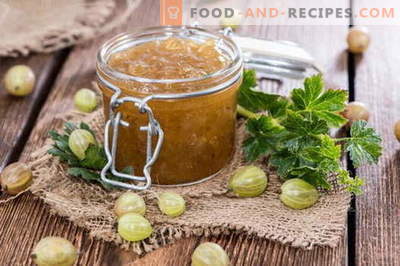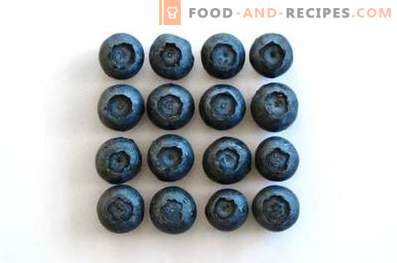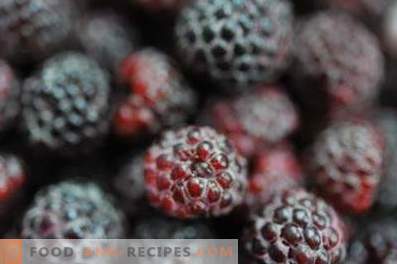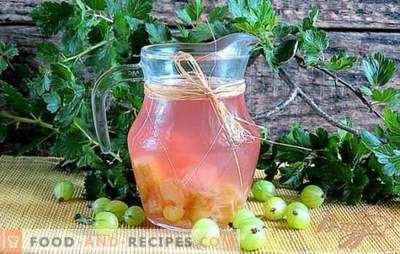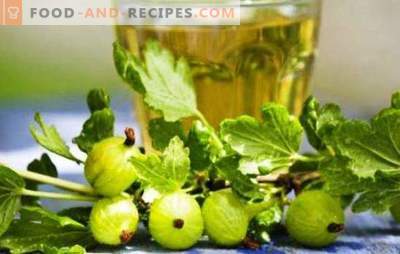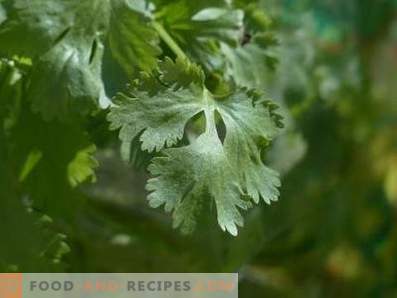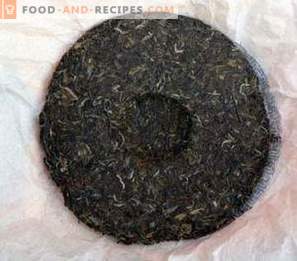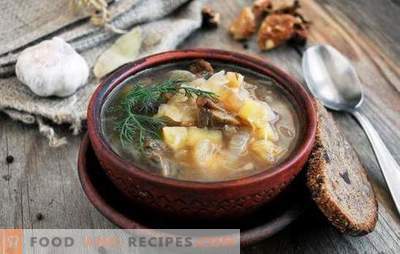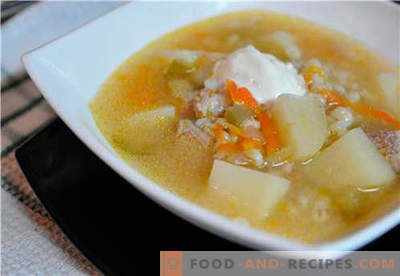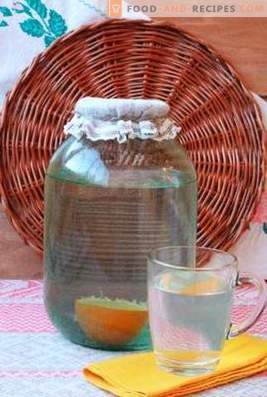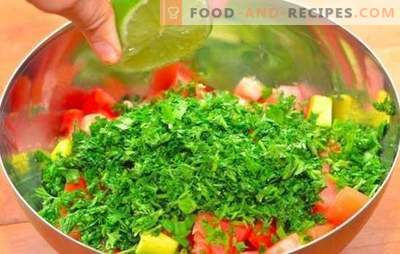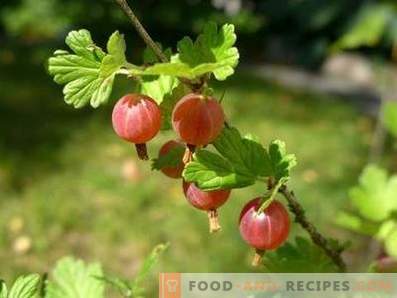
Gooseberry is a plant belonging to the Gooseberry family. The first written records of this culture were found in one of the French collections of church psalms dated to the XIII century. However, researchers have information that in the monastery gardens of Kievan Rus, gooseberries began to grow in the XI century. In antiquity, the plant was called "Bersen" or "Kryzh."
Gooseberry is a shrub up to 125 cm high. The branches of the plant, covered with dark brown or gray bark, are covered with usual or tripartite spikes. Pale green leaves of a culture sit on elongated, thin petioles. Leaf blades, divided into 3-5 lobes, have a heart-shaped or rounded shape, dull-toothed edge. The plant blooms in May with small reddish or greenish flowers.
Fruits of culture - yellow, green or burgundy berries spherical or oval in shape, reaching 35 mm in diameter. The gooseberry sweet pulp is enclosed in a dense smooth or coarse-skinned skin, dotted with well-marked veins. Fruits ripen in the second half of summer.
Gooseberry is widely used in cooking and the alcohol industry. Its fruits are eaten fresh, pickled or dried, used to make jam, compote, jelly, confectionery, wine. Berries and leaves of the plant are used in alternative medicine.
Nutritional value of gooseberry and vitamins in its composition
Nutritional value gooseberry (per 100 g):
- 0,62 g of proteins;
- 0, 182 g of fat;
- 9, 082 g of carbohydrates;
- 1, 206 g of organic acids;
- 3, 401 g of dietary fiber;
- 84, 622 g of water;
- 0, 557 g of ash.
Vitamins in the gooseberry (per 100 g):
- B9, folates - 4, 898 mkg;
- A, retinol equivalent - 32, 673 mcg;
- C, ascorbic acid - 29, 803 mg;
- beta-carotene - 0, 192 mg;
- B1, thiamine - 0, 009 mg;
- E, tocopherol equivalent - 0, 477 mg;
- B2, riboflavin - 0, 018 mg;
- PP, niacin equivalent - 0, 372 mg;
- B6, pyridoxine - 0, 027 mg.
Gooseberry calories
100 g of gooseberry contains 44, 903 kcal, in one fruit (2 g) - 0, 898 kcal, in a glass (165 g) - 74, 089 kcal. Calorie gooseberry jam - 211, 574 kcal per 100 g. Energy value of 100 g of gooseberry compote - 49, 012 kcal. In 100 g of dried fruits of the plant contains 223, 812 kcal.
Useful items in gooseberry
Trace elements in gooseberries (per 100 g):
- zinc - 0, 087 mg;
- iodine - 0, 907 mcg;
- nickel - 5, 793 mkg;
- copper - 129, 748 mkg;
- chrome - 0, 922 mkg;
- iron - 0, 787 mg;
- molybdenum - 11, 146 mkg;
- fluorine - 11, 798 mkg;
- manganese - 0, 447 mg.
Macroelements in gooseberry (per 100 g):
- sodium - 22, 496 mg;
- potassium - 259, 884 mg;
- chlorine - 0, 966 mg;
- sulfur - 17, 833 mg;
- calcium - 21, 903 mg;
- phosphorus - 27, 904 mg;
- magnesium - 8, 793 mg.
Useful properties of gooseberry berries
- Gooseberry contains a whole range of nutrients useful for the body. People who have the opportunity to eat at least a handful of these berries a day are reliably protected from avitaminosis.
- Iron and other substances that enter the body when consumed gooseberry heals the blood system. The fruits of this culture are useful to people who have been diagnosed with internal bleeding or anemia.
- The complex of nutrients that are present in the gooseberry helps to restore strength to people engaged in heavy physical or mental labor, underwent surgery or long-term illness.
- The fruit of the plant is a rich source of vitamin C and other compounds that strengthen the immune system. With regular inclusion in the menu of dishes prepared from them, the body's resistance to infections increases.
- Gooseberry juice has a choleretic and diuretic effect.
- Gooseberry flesh has laxative properties. Because of this, the fruits of the plant can be used to combat constipation.
- Vitamins of group B, which saturate the body with regular consumption of gooseberries, accelerate metabolism, strengthen the nervous system, normalize sleep.
- It has been observed that the nutrients contained in the fruits of a plant accelerate the excretion of radionuclides, toxic compounds, slags, salts of heavy metals and other poisons. Therefore, the gooseberry is recommended for people working in enterprises with harmful working conditions, undergoing chemotherapy or long-term courses of treatment with pharmaceuticals.
- Folk healers advise hypertensive patients to eat half a glass of gooseberry daily. In the pulp and juice of these berries there are substances that reduce blood pressure and give the walls of blood vessels extra strength.
- Antioxidant compounds that gooseberries are rich in, slow down the aging of tissues, help to improve the appearance of the skin, prevent the appearance of tumor growths.
- Gooseberry juice helps alleviate the unpleasant symptoms of most skin diseases. To achieve the effect enough to drink 4 tbsp. spoons of drink every 2 hours.
- Gooseberry is recommended for people suffering from arthritis. In order to alleviate the pain and prevent the spread of inflammatory processes, it is enough to eat a handful of berries a day.
- Gooseberry berries contain vitamins and useful elements that positively affect the work of the visual apparatus. It has been observed that people who regularly eat at least a handful of the fruits of this plant noticeably increase visual acuity.
- It has been proven that the substances contained in the gooseberry have a healing effect on the work of the reproductive system. Fresh berries of the plant and dishes based on them improve the composition of the ejaculate in men, normalize the menstrual cycle in women, reduce the risk of infertility in both sexes. In folk medicine, gooseberry fruit decoction is used to treat uterine bleeding. A glass of berries boil for 15 minutes in a liter of water and drink the resulting drink for the day.
- Gooseberry is rich in nutrients that strengthen tooth enamel and prevent the development of a whole range of dental diseases.
Benefits of gooseberry leaves
- Gooseberry tea is an effective means to fight tuberculosis. For its preparation, it is necessary to brew a handful of dried plant raw materials with a liter of boiling water, wait 45-50 minutes, filter. Drink a drink without restrictions before meals.
- Infusion of gooseberry leaves is a powerful diuretic. It is easy to prepare it: it is necessary to fill the glass for 1/8 with vegetable raw materials and for 7/8 with boiling water, infuse the mixture for 55 minutes. Take the tool for 4 tbsp. spoons every 2 hours.
- The rich decoction of gooseberry leaves is rich in tannins. Because of this, it is used as a bactericidal, hemostatic and anti-inflammatory agent for treating wounds. To prepare the broth, pour a glass of boiling water 2 tbsp. spoons of leaves, boil the mixture for 12-13 minutes and filter well.
- Tea from the leaves of gooseberry helps get rid of headaches. For its preparation, a teaspoon of leaves should be brewed with a glass of boiling water, kept warm for 40 minutes. Drink a drink without restrictions.
- Infusion of gooseberry leaves contains substances that accelerate lipid metabolism in the body and promote weight loss. People who are overweight need to drink a glass of this drink 25-30 minutes before a meal. To prepare it, pour in a liter jar filled with boiling water, a large handful of dried leaves and let the mixture stand for 40 minutes. Ready infusion should be well filtered.
- Gooseberry decoction can be used in the complex treatment of urolithiasis. To prepare the healing agent, it is necessary to finely chop fresh raw materials with a knife (1/2 cup), pour it into a thermos flask, pour boiling water (850 ml) and insist 4 hours. Drink every 14 hours? glasses of filtered drink.
- A weak infusion of gooseberry leaves, prepared at the rate of 1 teaspoon of raw material for 2 cups of water, has tonic properties. People suffering from caffeine intolerance can replace this drink with morning coffee.
- When gingivitis, stomatitis and other dental diseases, it is recommended to rinse your mouth with a saturated decoction of gooseberry leaves. For its preparation, boil 3 tbsp. spoons of raw materials in 200 ml of water for 15 minutes, skip through cheesecloth.
- Infusion of gooseberry leaves can be rinsed with weak, damaged hair. For the preparation of half a glass of raw materials should be poured with a liter of boiling water, to insist 2 hours.
Contraindications and harm of gooseberry
- Gooseberry is a potential allergen. Dishes from it are contraindicated in people who have previously been diagnosed with allergies to berries or fruits.
- Abuse of the fruits of the plant leads to indigestion, bloating, diarrhea.
- It is forbidden to eat gooseberries for people suffering from a stomach ulcer or duodenal ulcer. If you ignore this requirement increases the risk of exacerbation of the disease.
- Women who are breastfeeding should carefully include gooseberries in the diet. Substances present in the composition of its fruits, can provoke an allergic reaction or digestive problems in the baby.
- It is undesirable to give gooseberries to children under 9 months of age.
- It is strictly forbidden to eat gooseberries in case of diabetes.
- Broths and infusions prepared on the basis of gooseberry leaves are prohibited from ingestion before surgical interventions and for 16 days after them. Failure to comply with this requirement may lead to the development of internal bleeding in the operated person.
